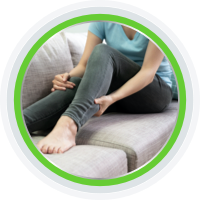Muscle sprains in children are as common as bumps, scrapes, cuts, and burns. This is attributed to the tendency of children to explore the environment around them fearlessly. For example, by jumping the gap between stepping stones. This is why it is important for all parents to be ready for the eventuality of a muscle sprain at any given time.
But what is a sprain? It is a type of muscle injury that affects a specific part of the body, mainly in the spaces where separate bones are connected. A variety of factors can cause a muscle sprain - from injury or overuse to stress, an infection, or even a side effect of using a drug1 - but this article will specifically focus on muscle sprains.
A sprain happens when a ligament - the tough bands of fibrous tissue that connects two bones together in joints - is overextended or torn when it is put under extreme pressure2. While this is a common occurrence in the ankles, a msucle sprain can also affects your knees, wrists and thumbs.

Causes
Factors that usually contribute to a child's sprained feet include, but are not limited to: Slippery or uneven surfaces, which can cause your child to lose balance This can cause your child's feet to make a sudden twisting motion, or for them to throw out their hands in order to catch their fall, causing their wrists or thumb to suddenly absorb the shock of a child's full body weight in mere seconds.
Some tell-tale signs of a muscle sprain in children included:
- The affected area being swollen or bruised
- Your child feeling pain at the affected area, which is accompanied by tenderness and muscle weakness
- Your child can't bear any weight or use a foot as they normally do
- Your child experiences muscle spasms or cramping in the affected area

First Aid for a Child's Muscle Sprain
A good first aid tip to keep in mind is the acronym R.I.C.E., which stands for rest, ice, compression, and elevation4,5,6.
Rest
Rest the injured area until it becomes less painful. Avoid putting any kind of weight or pressure on it. If possible, have your child lie down flat on his/her back if they have a sprained foot.
Ice
Wrap an ice pack or cold compress in a cloth or towel and place it over the injured foot right away. Do this for no more than 20 minutes at a time. This can help to reduce the pain, swelling, and bruising.
Elevate
Raise the injured foot above heart level (if your child is lying down) to help relieve the swelling. You can also opt to place pillows or a rolled up towel underneath the injured foot.
As long as it does not hurt your child too much, he or she can gingerly apply a bit of weight on the injured foot. This will help your child to be able to walk or stand normally again once the swelling and redness around the injured area has subsided7.
You can also give your child painkillers to help with the pain. Make sure to administer each dose as is recommended on the packaging. Another method is to apply an ointment containing eucalyptus oil and camphor, which possess anti-inflammatory properties that can help you to manage the swelling and pain in your child's foot.

If a sprain is not severe, it can usually heal by itself with adequate rest and care, as long as the R.I.C.E method is practiced, and the appropriate medicine administration is carried out. But if your child is still in a lot of pain, still can't bear any weight on the injured area, or if you are unsure about the injury itself, it is still best to take your child to see a doctor or healthcare specialist.
REFERENCES
- Muscle Pain: Possible Causes."" Cleveland Clinic. Accessed 19 September 2020. https://my.clevelandclinic.org/health/symptoms/17669-muscle-pain/possible-causes
- Sprains."""" Mayo Clinic. Accessed 19 September 2020. https://www.mayoclinic.org/diseases-conditions/sprains/symptoms-causes/syc-20377938
- Sprains and strains."" NHS. Accessed 19 September 2020. https://www.nhs.uk/conditions/sprains-and-strains/
- Sprains and Strains in Children."" Cedars Sinai. Accessed 19 September 2020. https://www.cedars-sinai.org/health-library/diseases-and-conditions---pediatrics/s/sprains-and-strains-in-children.html
- First Aid: Strains and Sprains."" Johns Hopkins Medicine. Accessed 19 September 2020. https://www.hopkinsallchildrens.org/Patients-Families/Health-Library/HealthDocNew/First-Aid-Strains-and-Sprains
- How to treat strains and sprains."" St. John Ambulance. Accessed 19 September 2020. https://www.sja.org.uk/get-advice/first-aid-advice/bones-and-muscle-injuries/strains-and-sprains/
- Foot Sprain in Children: Care Instructions."" My Health Alberta. Accessed 20 September 2020. https://myhealth.alberta.ca/Health/aftercareinformation/pages/conditions.aspx?hwid=ud3855


